St. Pauls, N.C.—Recently, members of the trade press were greeted by Watts Water Technologies executives for an exclusive tour of the company’s new Watts Works Learning Center. At the new, 3,000-sq.-ft. learning center, customers, channel partners, sales representatives, employees and other visitors can obtain hands-on and classroom training for a wide range of Watts products Read more
Featured Articles

St. Pauls, N.C.—Recently, members of the trade press were greeted by Watts Water Technologies executives for an exclusive tour of the company’s new Watts Works Learning Center. At the new, 3,000-sq.-ft. learning center, customers, channel partners, sales representatives, employees and other visitors can obtain hands-on and classroom training for a wide range of Watts products and solutions, which include Orion chemical piping systems, BLÜCHER stainless steel drainage, Watts cast iron drainage, Watts rainwater harvesting solutions, and Mueller Steam Specialty products, among others.
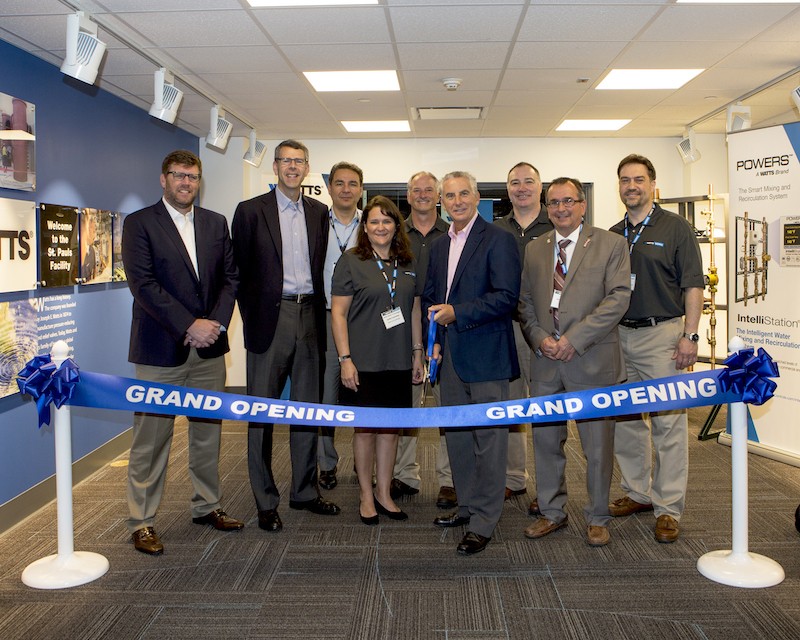
From l to r: left to right: Andrew Windsor, Watts Senior Vice President, Sales – Watts; Mark Hamilton, VP Drains, Americas – Watts; Roberto Vengoechea, Senior VP, Fluid Solutions – Watts; Jackie Comiskey, Indirect Sourcing Manager – Watts; Dennis Fackler, Facility Engineer – Watts; John Palotta, Vice President, Carolinas Operations – Watts; Chris Jamieson, Vice President, Marketing & Business Development – Watts; Gerald Weindel, Mayor, St. Pauls NC; Greg Gyorda, Director, Customer & Employee Training – Watts.
“This newest world-class Learning Center is part of our ongoing investment in education and training for our customers and our commitment to remaining a leader in training the industry,” said Greg Gyorda, Director, Customer & Employee Training.
“Through the Watts Works learning program, we are helping customers enhance their knowledge of a broad range of plumbing, drainage, HVAC, and water quality solutions,” he said. “In our hands-on demonstration labs and comprehensive classes led by experienced instructors, customers are able to enrich their professional skills.”

While taking the tour of the 220,000-sq.-ft. St. Pauls facility, products such as drains, strainers, butterfly valves are made, and the assembly of the IntelliStation digital mixing system, seen here.
Visitors to the St. Pauls Center—located within the 210,000-sq.-ft. St. Pauls manufacturing facility that employs 220 people—can also tour the factory to production of Orion Chemical Piping Systems, the Powers IntelliStation Digital Mixing System, Watts Manifolds and RainCycle Rainwater Harvesting systems, Mueller Steam Strainers, Check Valves, and many other products.
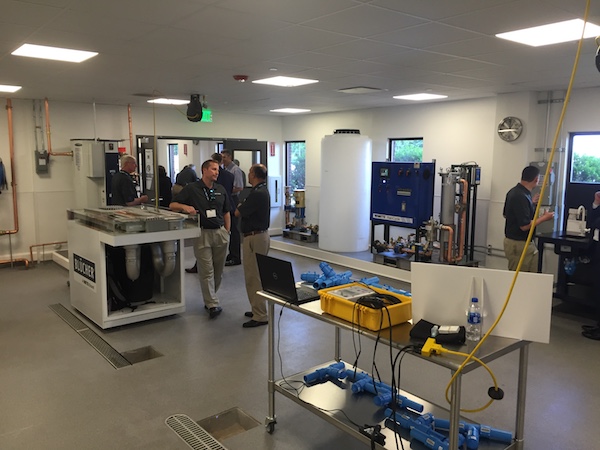
A look into the hands-on learning center.
According to VP Carolina Operations, and tour guide for the day, John Palotta, Watts has made a tremendous investment in time and money with the new Center. “Success is reflected in the products and support, but all of that would be nothing without the people here,” says Parotta.
The St. Pauls Center is the third Watts Works Learning Center in the U.S., joining Centers in North Andover, Mass., and Woodland, Calif.
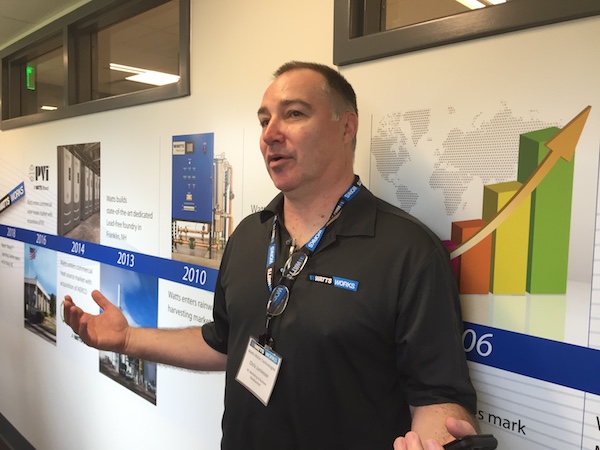
Chris Jamieson, Vice President, Marketing & Business Development, gives a brief history of the company to start the tour.

Today’s homes are becoming smarter and more efficient, thanks to the advancement of eco-friendly technologies and appliances—from tankless water heaters, low-flow toilets, to self-regulating thermostats. Homeowner Michael Craig, a huge proponent of this technological tide sweeping the country, wanted to upgrade his own 30-year-old residence in Lake Forest, Calif. “My wife and I are always Read more
Today’s homes are becoming smarter and more efficient, thanks to the advancement of eco-friendly technologies and appliances—from tankless water heaters, low-flow toilets, to self-regulating thermostats. Homeowner Michael Craig, a huge proponent of this technological tide sweeping the country, wanted to upgrade his own 30-year-old residence in Lake Forest, Calif.
“My wife and I are always looking for ways to incorporate advanced technology into our lives,” says Craig, himself a tech expert and owner of Bytelaunch, a digital marketing agency based in Orange County.
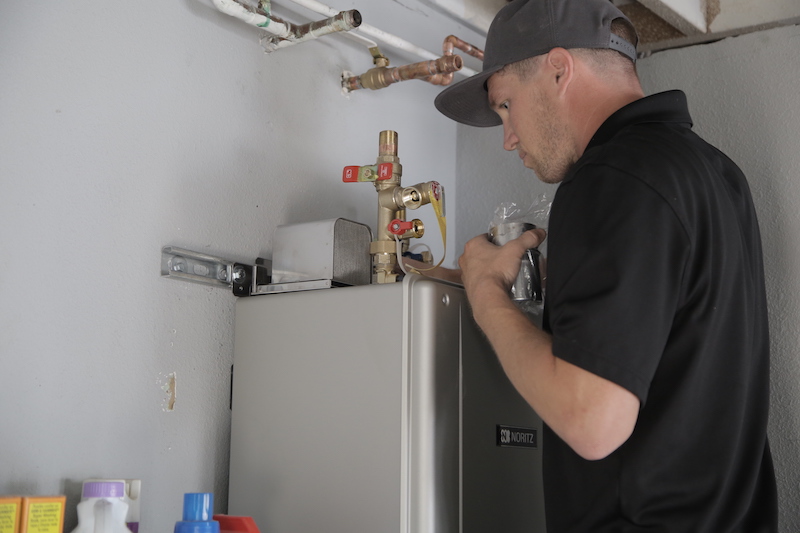
In particular, Craig zeroed in on replacing his storage tank water heater with something smarter and more efficient. “We had been considering installing a tankless water heater for a long time and kept the storage tank only because it had been brand new when we moved into our home,” recalls Craig. “After a few years, we were ready to pull the trigger.”
In the spring of 2017, he learned that Noritz had a tankless solution exceeding his expectations.
An EZ Solution
Craig decided to install the ENERGY STAR-certified EZ98-DV high-efficiency, condensing tankless water heater, designed to replace 50-gallon, storage-tank models directly. His installer, Jay Baril of Swift Water Heater, happened to be beta testing the unit for Noritz. The 0.97 energy factor of the EZ98 convinced him this was a green device he wanted in his home. “Unlike our old storage-tank water heater, which burned energy heating unused water, the EZ98 promised to fire only when we needed hot water,” explains Craig.
In addition to yielding energy savings, the EZ98 would bring Craig’s water heating system into the 21st century with its WiFi capability. By downloading the Noritz Connect app, he could take advantage of various remote functions, such as controlling the unit’s temperature and viewing error codes. “The mobile app was a big incentive for us because of our interest in the latest ‘internet of things’ innovations and smart-home trends,” says Craig.
Finally, the EZ98 unit’s direct-replacement design is intended to streamline hookup for installers swapping it in for a storage-tank unit:
- Unlike traditional tankless models, which offer only bottom-mount water-supply connections, the EZ98 unit’s connections are top-mounted—just like on the storage-tank unit being replaced. This eliminates the need to run additional plumbing lines, saving time and labor on the water connections.
- Venting options are also flexible, ranging from dual- or single-pipe (made of PVC or CPVC), to 2-inch Flex, which can be fed through the existing B-Vent.
Installer Baril opted for the 2-inch Flex for venting. He was also able to utilize the same half-inch gas line as the storage tank being replaced, avoiding the hassles and expenses of upsizing. The five-year industry veteran confirms that its configuration creates the potential for time savings.
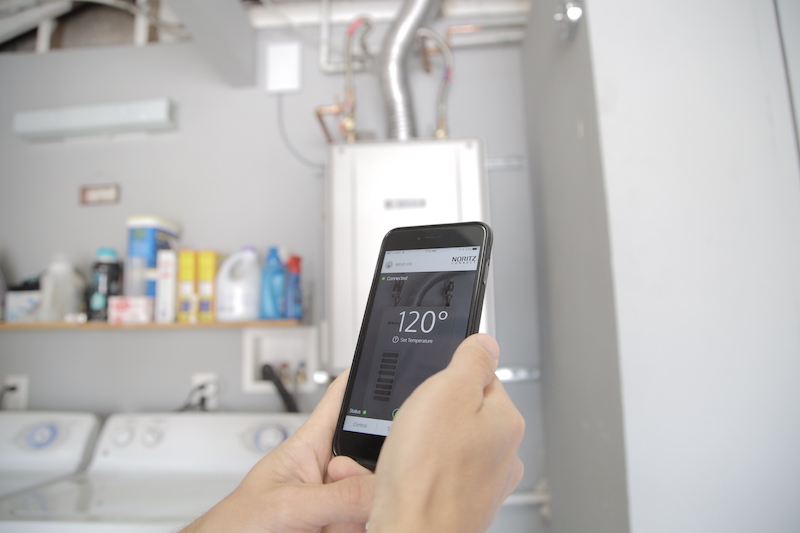
“The engineers designing this unit put a lot of thought into streamlining the installation, which is always what plumbers look for in evaluating a new solution,” says Baril, who commonly works with storage tank heaters but was impressed with the tankless unit’s ease-of-installation. “The mounting bracket makes the unit easy to position, eliminating the need for a second installer. The top-mount connections are super easy and look very professional. The defining benefit for me, though, was the ability to use the existing B-Vent, not only in terms of saving time, but also because it means I never have to turn down an installation for lack of venting options.”
Comfort and Savings
Immediately after the installation, Craig reported low water pressure, which was later tied to a problem in the piping system and repaired. For its part, the EZ98 began heating the 1,800-square-foot home without issue, supplying hot water for three full bathrooms, a laundry room and a kitchen.
“The water pressure is now perfect, and the heat feels much more consistent across all our fixtures than previously,” says Craig, discussing the improved comfort he and his wife enjoy. “There are no more worries about running out of hot water in the middle of a shower, and the remote control with the wireless app is super-convenient, fitting right into our smart-home goals.”
The wall-hung unit also delivered one other key benefit: “The tankless water heater uses up much less real estate,” notes Craig. “We keep a washer and dryer in the same room, and now there’s more space to maneuver around these appliances.”
Last, but far from least, the switch to tankless is having a positive impact on Craig’s pocketbook. Since the EZ98 fires only on demand, the gas savings began to accrue from Day One. In 2016, with the storage tank heater, Craig’s monthly gas bill totaled an average of $17.19. In 2017, with the tankless water heater in place, the average monthly bill has decreased to $14.14. Estimates Craig, “We are saving an average of 17.7 percent on our monthly gas bill, largely due to tankless.”
In addition to the tankless water heater, Craig is gradually adding other smart, energy-efficient products to his lifestyle. He drives an electric car; has installed a thermostat that “learns” a user’s habits and adjusts accordingly; and has even considered adding solar energy to his home.
“Where others see a 30-year-old home, my wife and I see an opportunity to evolve into something greater and more sustainable,” explains Craig. “Who knows what we’ll upgrade next?”

OSHA’s Crystalline Silica Standard will be in effect September 23, 2017. OSHA is issuing the standard to protect workers from exposure to respirable crystalline silica in the construction industry in order to allow employers to tailor solutions to the specific conditions in their workplaces. The new standard has had tool manufacturers working overtime to engineer Read more
OSHA’s Crystalline Silica Standard will be in effect September 23, 2017. OSHA is issuing the standard to protect workers from exposure to respirable crystalline silica in the construction industry in order to allow employers to tailor solutions to the specific conditions in their workplaces.
The new standard has had tool manufacturers working overtime to engineer tools and too attachments that will keep us productive while meeting the dust collection requirements. Here at The Hub we will be sharing reviews and information in the coming days and weeks leading up to September 23 date showing the various tools and attachments you might consider for your own compliance. Here is our first review:
https://youtu.be/mWLfwgkPLCc
Bosch HDC100 Dust Collection Attachment
Bosch knows concrete and the tools needed to work efficiently and effectively on the plumbing & hvac job site. Whether you’re working with a Bosch Bulldog rotary hammer or nearly any other modern rotary hammer of another brand this attachment is simple to install and use and is priced right in our opinion.
 We’re referring to the HDC100 as a “universal” attachment, though it’s not listed as such on Bosch’s website it will fit any modern rotary hammer with a barrel mounting neck for a standard auxiliary handle (see pic above).
We’re referring to the HDC100 as a “universal” attachment, though it’s not listed as such on Bosch’s website it will fit any modern rotary hammer with a barrel mounting neck for a standard auxiliary handle (see pic above).
The 1.5lb composite plastic dust collection attachment has a built-in depth stop with a maximum drilling depth of 4-3/4” and can handle SDS drill bits up to ¾” diameter, dry core drilling up to 3-1/8” diameter [when using the core bit adapter, included].
As seen in the video the HDC100 is very effective at collecting nearly 100% of the dust from the ½” holes drilled for the drop-in anchors, an extremely common task on any mechanical job site. The dust port can be hooked up to a 1-3/8-In. vacuum hose nozzle, or it can accommodate 1-1/4-In. or 2-In. nozzles when combined with an appropriate optional adapter.
It is important to note that the HDC100 alone is not all that is needed for compliance with the OSHA standard. The HDC100 must be connected to a HEPA rated dust collector vacuum that meets the minimum requirements of the Crystalline Silica Standard to be compliant. In the video we are using the Bosch GBH18V-26 18V EC Brushless 1 In. SDS-plus® Bulldog Rotary Hammer and Bosch VAC090A 9 Gallon Dust Extractor with Automatic Filter Clean.
We have done some online price searches and found that nearly all Bosch tool retailers are listing the HDC100 at $69-70 US, its available for purchase currently.
This is only one of many tools Bosch has engineered to meet the OSHA standard, please watch for reviews of additional tools soon here on mechanical-hub.com.

https://youtu.be/OKchhHbl2SA The Hub’s Eric Aune visits with Uponor’s head of training Wes Sisco to discuss some new plumbing applications Read more
The Hub’s Eric Aune visits with Uponor’s head of training Wes Sisco to discuss some new plumbing applications.

https://www.youtube.com/watch?v=_b-m69_obcM I have to be honest. I don’t normally stand around in 4”-5” of water on the job. I do however walk through unplowed driveways, parking lots and through the rain while moving tools and equipment in and out of the truck so having dry feet is paramount to capping off a good day at Read more
https://www.youtube.com/watch?v=_b-m69_obcM
I have to be honest. I don’t normally stand around in 4”-5” of water on the job. I do however walk through unplowed driveways, parking lots and through the rain while moving tools and equipment in and out of the truck so having dry feet is paramount to capping off a good day at work.
I’ve been wearing the KEEN Utility Pittsburgh boots for work [and play] for a couple months now and I’m impressed not only with the KEEN.DRY system but the comfort and support has surpassed my expectations. For those not familiar, the KEEN.DRY system is a proprietary waterproof membrane that lets vapor out without letting water in. I’d put it up against the major brand of waterproofing we’re all familiar with.
 The support and protection built-in include full-length TPU stability plate providing forefoot flexibility and underfoot stability; when mated with the metatomical footbed design where an engineered arch support cradles your foot for all day comfort.
The support and protection built-in include full-length TPU stability plate providing forefoot flexibility and underfoot stability; when mated with the metatomical footbed design where an engineered arch support cradles your foot for all day comfort.
I’ve been a longtime wearer of natural leather upper boots so moving into a composite build boot of natural leather and cloth took a little getting used to. Boots like the Pittsburgh are slightly bulkier than the typical all-leather boot but that has more to do with the engineering in design for flexibility and durability. Rubber, cloth, nubuck leather all play a role in the upper build of the boot.
The soles are non-slip oil resistant rubber and provide aggressive traction on this model. I’m more accustomed to a less “off-road” tread but I haven’t found anything negative to say about the tread pattern; if I have any comments on the tread I’d say climbing my step ladder is where I most notice the aggressive pattern. Once in a while my foot will catch on the edge of a ladder rung where it may not have with a smoother, more typical work boot tread pattern.
 Overall I’m impressed with the KEEN Utility Pittsburgh boots. Material quality is very high, build quality as well. Comfort concerns went straight out the window after day one of wear and have not changed in the short time I’ve been putting them to work. I’ve got my eye on a few other models that may be a little closer to what I’m used to for style and features but, these being the most popular model in the US [in Canada they’re known as the Hamiltons] I’m not surprised based on the overall quality and design.
Overall I’m impressed with the KEEN Utility Pittsburgh boots. Material quality is very high, build quality as well. Comfort concerns went straight out the window after day one of wear and have not changed in the short time I’ve been putting them to work. I’ve got my eye on a few other models that may be a little closer to what I’m used to for style and features but, these being the most popular model in the US [in Canada they’re known as the Hamiltons] I’m not surprised based on the overall quality and design.
Click this link to visit KEEN’s site and see more about the Pittsburgh boots.
